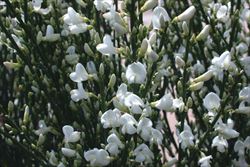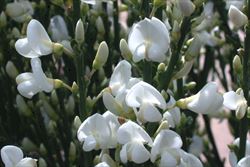Click on images to enlarge

white flowers arranged along upright stems (Photo: Rob and Fiona Richardson)

close-up of pea-shaped flowers (Photo: Rob and Fiona Richardson)
Scientific Name
Cytisus multiflorus (L'Hér.) Sweet
Synonyms
Cytisus albus LinkSpartium multiflorum L'Her.
Family
Fabaceae (Queensland, the ACT, Victoria, Tasmania and the Northern Territory)Fabaceae: sub-family Faboideae (New South Wales)Leguminosae (South Australia)Papilionaceae (Western Australia)
Common Names
white Spanish broom, white Spanishbroom
Origin
Native to south-western Europe (i.e. France, Portugal and Spain).
Cultivation
White Spanish broom (Cytisus multiflorus) is widely cultivated in the cooler regions of Australia as a garden ornamental.
Naturalised Distribution
This species currently has a limited naturalised distribution in south-eastern Australia (i.e. naturalised in central Victoria and south-eastern South Australia). In Victoria it is locally common near the towns of Creswick and Castlemaine, while in South Australia it is restricted to the Southern Lofty Mountains region (it has possibly been eradicated from this region).
Also naturalised overseas in the UK, New Zealand and western USA (i.e. California, Oregon and Washington).
Habitat
A weed of roadsides, disturbed sites, urban bushland and open woodlands in temperate regions. Potentially also a weed of pastures, forestry plantations and grasslands.
Habit
A large shrub usually growing up to 3 m tall, but occasionally reaching 4 m in height.
Distinguishing Features
-
a large shrub usually growing up to 3 m tall with stems that are mostly upright.
-
its greenish stems are finely ribbed and covered with short hairs.
-
leaves on the lower branches have three small leaflets, while those on the upper branches only have a single leaflet.
-
its pea-shaped flowers (9-12 mm long) are white with some faint pink markings at the base.
-
its small pods (15-30 mm long) and are covered with short hairs and turn black as they mature.
Stems and Leaves
The upright stems are greenish in colour and finely ribbed lengthways (i.e. they are striate). Younger stems are covered with short hairs (i.e. they are puberulent) but these are lost as the stems age.
The leaves on the lower branches are compound with three leaflets (i.e. they are trifoliate), while those on the upper branches only have a single leaflet (i.e. they are unifoliate). These leaves are alternately arranged along the stems and the leaflets are covered in silky hairs (i.e. they are pubescent) that give them a greyish-green appearance. Individual leaflets are relatively small (up to 12 mm long and 4 mm wide), elongated in shape (i.e. lanceolate or narrowly oblong), and have pointed tips (i.e. acute apices).
Flowers and Fruit
The pea-shaped flowers (8-12 mm long) are white with some small pink markings at the base. They are borne in groups of 1-3 in the leaf forks (i.e. axils) and arranged into long spike-like clusters towards the tips of the branches. Each flower has a larger and broader upper petal (i.e. a standard), two smaller side petals (i.e. lateral or wing petals), and two lower petals that are fused together and folded (i.e. a keel). They also have five green sepals that are fused together for most of their length (i.e. into a calyx tube) and ten stamens that are also fused together for most of their length. In the centre of the flower is an elongated ovary topped with a long and slender style and a stigma. Flowering occurs mostly during spring and early summer (i.e. from September to December) and is usually very prolific and relatively short-lived.
The fruit are slightly elongated (i.e. linear-oblong) pods and are covered with short hairs (i.e. they are finely pubescent). These pods (15-30 mm long and 4-7 mm wide) turn from green to black as they mature and release their seeds explosively when fully ripe. Each of the pods contains 3-7 seeds (2.5-3.0 mm long) that are olive to brown in colour. The pods are present mainly during summer.
Reproduction and Dispersal
White Spanish broom (Cytisus scoparius) generally reproduces by seed, but infestations may also spread locally through stem pieces taking root.
Most of the explosively released seeds fall within 1 m of the parent plant. However, they may be spread over longer distances by water or in mud attached to vehicles, machinery, footwear and animals. Seeds and stem pieces may also be dispersed in dumped garden waste.
Environmental Impact
White Spanish broom (Cytisus multiflorus) is on the national Alert List for Environmental Weeds and is regarded as a serious environmental weed in Victoria. Although this species is only in the early stages of establishment, it has the potential to seriously degrade Australia’s ecosystems, by threatening biodiversity and causing other environmental damage. It is known to invade relatively undisturbed bushland and it is thought pose a threat to a wide range of disturbed and undisturbed native habitats, such as grasslands and open eucalypt woodlands.
Like other brooms (e.g. Cytisus spp. and Genista spp.) it can fix nitrogen and change soil fertility. It can form a dense shrub layer that outcompetes native species, shades out native herbaceous groundcover plants and prevent the regeneration of eucalypt seedlings.
Other Impacts
White Spanish broom (Cytisus multiflorus) may form thickets in pastures, preventing grazing and restricting access to water. It also provides shelter for feral animals and its seeds are poisonous. Like its close relative Scotch broom (Cytisus scoparius subsp. scoparius), it could also become a major weed of forestry plantations.
Legislation
This species is declared under legislation in the following states and territories:
- ACT: C2 - a pest plant that must be suppressed, and C4 - prohibited pest plant (a pest plant whose propagation and supply is prohibited). This declaration also applies to all Cytisus spp.
- Tasmania: D - the importation or sale of this species is prohibited and measures to reduce its population in an area, eradicate it from an area, or restrict it to a particular area may be required.
- Western Australia: Unassessed - this species is declared in other states or territories and is prohibited until assessed via a weed risk assessment (throughout the entire state).
Similar Species
White Spanish broom (Cytisus multiflorus) is very similar to tree lucerne (Chamaecytisus palmensis) and the white weeping brooms (Retama monosperma and Retama raetam). These species can be distinguished by the following differences:
- white Spanish broom (Cytisus multiflorus) has upright branches and relatively small leaflets (up to 12 mm long and 4 mm wide) with hairy (i.e. pubescent) surfaces. Its relatively small elongated fruit (1.5-3 cm long) are softly hairy (i.e. pubescent) and turn dark brown or black and split open when mature.
- tree lucerne (Chamaecytisus palmensis) has drooping branches and relatively large leaflets (10-50 mm long and 4-16 mm wide) with hairy (i.e. pubescent) undersides. Its relatively large and elongated fruit (4-6 cm long) are softly hairy (i.e. pubescent) and turn dark brown or black and split open when mature.
- the white weeping brooms (Retama monosperma and Retama raetam) have drooping branches and very small leaflets (about 5 mm long and 1 mm wide) that are quickly shed. Their small fruit (1-1.5 cm long) are hairless (i.e. glabrous) and turn light brown and do not readily split open when mature.
It is also similar to many of the other brooms (e.g. Genista spp. and Cytisus scoparius subsp. scoparius), however these other species can be easily distinguished by their yellow flowers.
This fact sheet has been updated thanks to the sponsorship of Sunshine Coast Council.

